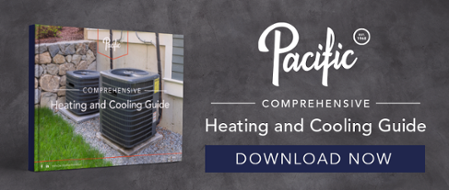
HVAC stands for heating, ventilation, and air conditioning. In many homes, an HVAC system integrates all three of these individual functions, working together to deliver clean, fresh air throughout the year. Today, we’re going back to the basics to give you a good foundation of understanding for the next time you need to repair or replace your home’s system.
To keep this post simple, we’re going to focus on central, forced-air systems. Check out our blog to learn about how heat pumps and ductless systems work.
Heating and Cooling the Air
Many homeowners have a central air system, with a furnace as the heating component and an outdoor condensing unit as the cooling component. If you have a conventional HVAC system, both the warm and cool air are likely distributed by the same ductwork, and you control the temperature using a single thermostat.
Furnace
A furnace heats the air and then pushes it throughout your home via air ducts and vents. A furnace can be powered either by electricity or by burning fuel such as gas, oil, or propane.
Air Conditioner
An air conditioner runs on electricity and cools the air by removing heat and humidity to make your home more comfortable. The process of cooling the air in your home involves
- a liquid substance—known as coolant—that lives inside the evaporator coils attached to your furnace and
- an outdoor condenser unit with a compressor and condenser coils.
As air blows across the evaporator coils, the refrigerant inside them absorbs the heat and moisture and is converted into hot vapor. This hot vapor is then sent to the outdoor condenser unit. Inside the condenser, the vapor sweeps across condenser coils where it cools, releases the heat, and returns to its liquid state. The released heat is blown outside, and the liquid is transported back indoors so the cycle can begin again
Learn more details of how the cooling process works in our previous article, “How Does My Air Conditioner Work?”
Distributing the Air
In a forced air system, heated or cooled air is circulated through a series of ducts. In the heating season, the furnace draws in cool air throughout your home, heats it, and then blows the warm air into the duct system so it can be distributed through vents throughout different rooms in your home. The distribution process for the cooled air is the same; after the cooling process, the air flows up through your vents and into your living space.
Controlling the Temperature
Your thermostat has a heat-sensitive switch that controls the temperature in your home all throughout the year. When you lower or raise the temperature to make your space cooler or warmer, your HVAC system will kick on to circulate air until it reaches the desired level.
If you need heating and cooling services in the Roaring Fork Valley area, contact Pacific! We can make repairs on your HVAC system or replace an old furnace or air conditioner with a new, highly efficient system you’ll love. Contact us today!
